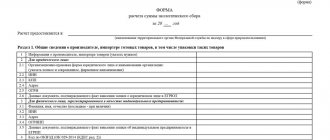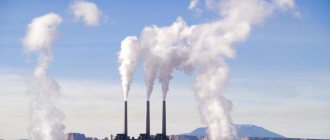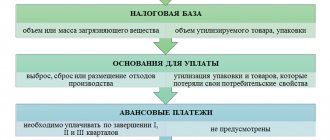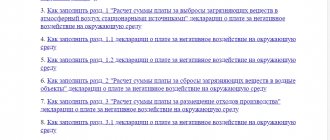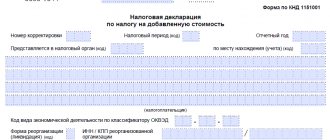Tax entry deadline
One of the reasons for introducing the new tax is the redistribution of responsibilities for collecting funds from organizations that have a negative impact on the environment.
Until 2021, the responsibility for collection fell on the relevant agency – Rosprirodnadzor. The government agency, which did not have payments as its main task, achieved less than half of the required volume of compensation for damage caused to the environment.
The transfer of responsibilities to the Federal Tax Service, which has the necessary experience in collecting debts and organizing the payment of mandatory payments, should lead to an increase in budget revenues. In theory, this will provide new resources to protect the environment. All funds collected will go into the general budget, from which money will then be allocated for environmental protection.
In addition to changes in the recipient of payments, the type of payment itself has changed: the environmental fee has become a tax. The new legislative provisions largely duplicate the content of the current federal law of January 10, 2002 No. 7-FZ (Article 16). According to the drafters, the environmental tax should maintain the status quo for organizations making payments. The changes will only affect unscrupulous enterprises that are required to make payments but do not do so. From 2021 they will be responsible to the tax authorities.
From January 1 to March 1, 2021, there will be a transition period during which Rosprirodnadzor will transmit data on organizations that have a negative impact on the environment to the Federal Tax Service. Over the next 10 years (until December 31, 2029), a reduced penalty interest rate of 10% will apply for defaulters. Changes to the Tax Code are expected to come into force on January 1, 2021.
Who is the payer of the tax collection fee?
According to Art. 16.1 of Federal Law No. 7-FZ of January 10, 2002 “On Environmental Protection” all organizations and individual entrepreneurs that have the following impact on the environment:
- emit pollutants into the air through stationary sources;
- or release pollutants into water bodies;
- or are engaged in the storage and disposal (disposal) of waste,
are required to pay for negative impacts on the environment.
Please note the following points:
- Only emissions from stationary sources are taken into account; mobile sources of emissions have not been taken into account for a long time.
- If an organization only generates waste and has a contract for waste removal, then ownership of this waste does not transfer anywhere. Those. the organization must pay the NVOS for its own waste placed at the landfill. The exception is the payment for solid waste if there is an appropriate agreement with the regional operator.
- The obligation to pay the NVOS arises regardless of whether the organization is the owner of the production facility or leases it.
Taxpayers of environmental tax
The main principle by which taxpayers will be determined is harm to the environment. First of all, individual entrepreneurs and organizations are subject to taxation. Another condition is that the category of the facility where the activity is carried out is taken into account. The tax applies only to the first three categories.
| Conditions | Taxpayers |
| Negative impact on the environment | Organizations, individual entrepreneurs |
| Generation of waste, except MSW | Organizations, individual entrepreneurs |
| Working with MSW | Regional operators |
| Activities at stationary facilities of categories 1-3 | Organizations, individual entrepreneurs |
| Production or import of goods and packaging that are disposed of after use | Organizations, individual entrepreneurs |
| Manufacture or import of wheeled vehicles or chassis | Organizations, individual entrepreneurs |
| Purchasing vehicles from persons who have not paid the recycling fee | Organizations, individual entrepreneurs |
For example, transportation companies using trucks are not taxed because the vehicle is not a stationary source of emissions.
Each taxable person is required to register with the local tax office within 30 days of registration with the state. Within 10 days, Rosprirodnadzor transmits to the Federal Tax Service information on new facilities that negatively affect the environment. The accounting breakdown is as follows:
- Rosprirodnadzor takes into account objects;
- Federal Tax Service - taxpayers.
For activities falling into category 4, it is necessary to obtain appropriate confirmation. The total number of objects in Russia that have a negative impact on the environment is more than 250 thousand.
Objects of taxation
Activities that are negative for the environment are identified as objects of taxation.
are not subject to environmental tax :
- activities financed from the budget of any level;
- objects that do not have a negative effect on the environment;
- packaging and reusable products;
- export goods produced on the territory of the Russian Federation;
- use of rocks and ferrous metal production waste (hazard class 4-5) to fill cavities during reclamation;
- accumulation of raw materials for subsequent disposal or disinfection within 11 months after appearance;
- Category 4 emissions at the facility;
- old vehicles (more than 30 years old) while maintaining their original condition.
Other production activities of the enterprise are taxed if they have a negative impact:
- atmospheric emissions from stationary sources;
- discharge to wastewater;
- processing of waste of any hazard class.
In addition to activities, objects act as objects:
- waste goods and packaging;
- transport packaging (used for packaging several units);
- vehicles according to the list.
Rates applied for calculation for 2021
Decree of the Government of the Russian Federation No. 913 dated September 13, 2016 approves the rate for calculating the fee for the NVOS.
| Sources of environmental pollution | Criteria for setting a bid |
| Stationary sources of pollution producing emissions into the atmosphere | For each pollutant |
| Discharges into water bodies | For each pollutant |
| Disposal of production and consumption waste | Waste hazard class |
Please note that Regulation 913 provides rates for 2016, 2021 and 2021. At the same time, by Decree of the Government of the Russian Federation dated June 29, 2018 No. 758, the rates of payment for the negative impact on the environment when disposing of solid municipal waste of hazard class IV for 2021 are indexed.
If you are using the Environmental User Module, be sure to update the program version to take into account the latest changes in legislation.
The tax base
When calculating the tax value, several indicators related to volume and mass are used as a base:
- atmospheric emissions;
- dumping into water;
- disposed waste.
Additional characteristics can raise or lower the final indicator:
- waste recycling (reduces);
- exceeding the standards established by Rosprirodnadzor (increases).
All types of waste processed and generated at the enterprise are taken into account. Data is collected from each stationary source based on the results of environmental monitoring at the enterprise. All values used are based on the contractual relations of the organization itself, which enters into agreements for the removal and disposal of waste.
Tax rate
The tax rate is different for each type of waste or raw material.
For loose goods, the calculation is based on each ton; for piece goods, per unit. In addition, the specifics of the product determine the use of coefficients.
Specific characteristics include some vehicle data, for example:
- year of issue;
- engine power;
- number of axes.
For each product or package, the tax rate will be similar to the current environmental fee. The size consists of 4 characteristics:
- the mass of goods sold in Russia during the year;
- coefficient;
- mass of reused goods;
- bid.
Rate value for some products:
| Product or waste | Bet size, rub. |
| Self-propelled vehicles and trailers | 172 500 |
| Other modes of transport | 150 000 |
| Lead acid batteries | 27 320 |
| Wheeled vehicles (category M1, G) | 20 000 |
| Chlorine | 181,6 |
| Nitrogen dioxide, sodium carbonate, ammonia | 138,8 |
Rules for calculating charges
Each taxpayer calculates the amount of environmental tax independently, taking into account each source of negative impact on the environment, hazard classes, and activities of hazard categories 1-3. A year after the law comes into force, a coefficient reflecting changes in consumer prices will begin to be applied.
To motivate to reduce emissions and waste generation, appropriate increasing factors will be applied:
| Meaning | Condition of use |
| 100 | Exceeding the established weight, lack of results from the emission reduction program |
| 25 | Within the limits of the temporarily permitted excess |
To calculate the tax, a formula similar to calculating the size of the environmental fee is used:
C = K * M * N, where
C – amount of tax or fee,
K – coefficient,
M – mass for disposal minus processed raw materials,
N – normal.
How to calculate the amount of the tax assessment?
Calculation of the amount of payment for negative environmental impact depends on the following factors:
- nature of the source of pollution;
- type of pollutant (or its hazard class);
- volumes of actual emissions;
- the fact that there are no means of measuring emissions;
- presence of excess pollution above established standards;
- the fact that the contaminated object or territory is under special protection;
- expenses incurred on measures to reduce negative impacts.
Based on the first 2 indicators, the rate used in the calculation is determined. By multiplying it by the volume of actual emissions (if it does not exceed the maximum permissible) the amount of payment for pollution is determined. The following odds are applied to the bet amount:
- increasing, if we are talking about the lack of means of measuring emissions, exceeding permissible pollution standards, or the location of an object (territory) under special protection;
- reducing, depending on the hazard class of the disposed waste, the method of its generation and disposal.
To calculate the amount of payment for the environmental impact assessment, the following methodology is used (approved by Decree of the Government of the Russian Federation dated 03.03.2017 N 255 “On the calculation and collection of fees for negative impacts on the environment.”
The amount of payment for the NVOS can be calculated in the Natural Resources User Module.
Reducing the payment amount
Coefficients are used as a punishment for exceeding standards, as well as as an incentive for enterprises using innovative waste treatment methods.
The key condition for using a reduction factor is that innovations must reduce the negative impact or reduce the volume of destroyed waste. For example, if waste of hazard class 3 after processing became less hazardous class 4, then such work is encouraged by a reduction in the payment amount.
Several values are used to reduce the payment as much as possible up to 70%:
| Meaning | Condition of use |
| 0,3 | When working on your own territory and not exceeding limits |
| 0,33 | Disposal of class 4 waste generated during the processing of class 2 waste |
| 0,49 | Disposal of class 4 waste generated during the processing of class 3 waste |
| 0,5 | Disposal of class 4-5 waste generated during processing of waste from the processing and mining industries |
| 0,67 | Disposal of class 3 waste generated during the processing of class 2 waste |
When introducing the best technologies paid for by the enterprise in the field of environmental protection, a zero coefficient can be applied, which resets the entire tax amount. Situations in which an enterprise may not legally pay environmental tax:
- achieving standards after the introduction of technologies at a facility that has a negative impact on the environment;
- the accumulated waste is reused for our own needs or transferred to another organization for this purpose.
Procedure and deadline for tax payment
Data for 1 calendar year are used as the taxation period.
All calculations must be made before March 25 of the following reporting year. A scheme of advance payments is used, which are accepted after the reporting period: 1-3 quarters of the year. New taxpayers begin making payments on January 1 of the following year after registering with the Federal Tax Service.
An advance scheme is used to pay the environmental tax, except for small and medium-sized businesses. In total, the payment consists of 4 parts:
- 3 advance payments equal to a quarter of the amount for last year - for the first 3 quarters;
- payment of the balance.
The final payment deadline is no later than March 25 of the year following the reporting year. Quarterly payments are paid no later than the 20th day of the first month of the next quarter.
When and how to pay?
Payment is made annually before March 1 of the year following the reporting year (Clause 3, Article 16.4 of Law No. 7-FZ of January 10, 2002). The amount of payment is determined as the amount of the annual fee minus advances paid and expenses for measures to reduce the negative impact.
Who pays advances and how?
According to paragraph 3 of Art. 16.4 of Federal Law No. 7-FZ of January 10, 2002 “On Environmental Protection” small businesses do not pay advances; other enterprises and organizations pay advances quarterly during the reporting year no later than the 20th day of the month following the next quarter. The advance amount is calculated as ¼ of the total amount of the negative impact fee for the previous year.
Such accrual of advance payments often leads to significant overpayments to the budget. Therefore, back in 2021, a draft Government Resolution was published, which proposed two other options for calculating the advance payment:
- Pay an advance in the amount of 1/4 of the fee amount calculated on the basis of established standards for permissible emissions, discharges of pollutants, temporarily agreed upon emissions, temporarily agreed upon discharges and limits on the disposal of production and consumption waste.
- Pay an advance in an amount equal to the amount of payment calculated for the actual negative impact on the environment in the past quarter based on industrial environmental control data.
Payment for negative environmental impact is carried out according to the following BCC:
| Payment name | KBC in 2018-2019 |
| Payment for emissions of pollutants into the atmospheric air by stationary facilities, with the exception of those generated during flaring and (or) dispersion of associated petroleum gas | 048 1 1200 120 |
| Payment for discharges of pollutants into water bodies | 048 1 1200 120 |
| Fee for disposal of industrial waste | 048 1 1200 120 |
| Fee for disposal of municipal solid waste | 048 1 1200 120 |
| Payment for emissions of pollutants generated during flaring and (or) dispersion of associated petroleum gas | 048 1 1200 120 |
Submitted reporting
Filling out a tax return occurs only electronically. The taxpayer provides and takes into account the following data:
- volume and class of waste for each source;
- bet and odds.
The first indicator is determined through environmental control, as well as on the basis of acts of acceptance and transfer of waste for disposal to third parties. All provided data related to waste management must be confirmed by the regulatory authority - Rosprirodnadzor. When filling out the electronic form, indicate the place of filing the declaration - the local branch of the Federal Tax Service.
Procedure for filling out the declaration
The form is not completed for exported goods and packages. Goods and packaging produced in Russia, EAEU countries, and third countries are included in the declaration (after completing customs procedures).
The declaration of manufacturers is filled out on the basis of accounting documents, importers - customs and transport. Each name and each unit of goods is taken into account, as well as weight with a discrepancy from the actual one of no more than a kilogram.
NVOS Declaration
In addition to paying for the NVOS, it is necessary to annually draw up a corresponding declaration (see Order No. 3 of 01/09/2017) and submit it no later than March 10 of the year following the reporting year.
Order No. 3 of the Ministry of Natural Resources of Russia dated January 09, 2017 presents in detail the rules for filling out the declaration, and also contains the necessary coefficients and methods for checking the correctness of data entry for each section of the declaration. In addition, the calculation procedure for each type of polluting object is described in detail in Decree of the Government of the Russian Federation dated March 3, 2017 No. 255.
The declaration can be filled out using the Nature User Module. Once again we attach the corresponding instructions (it was also above) and additional files.
